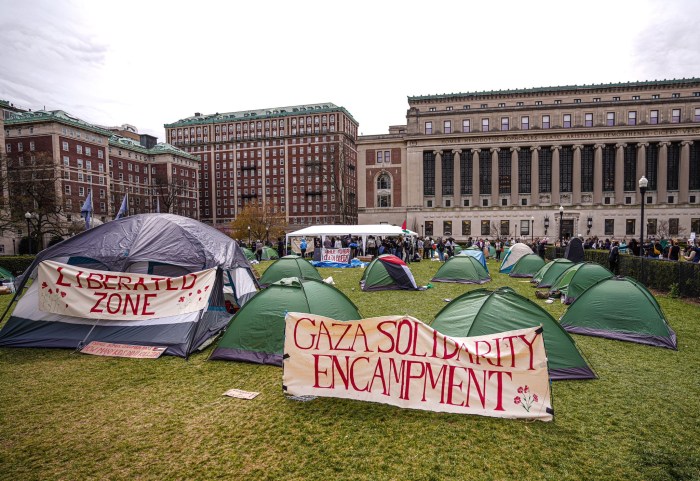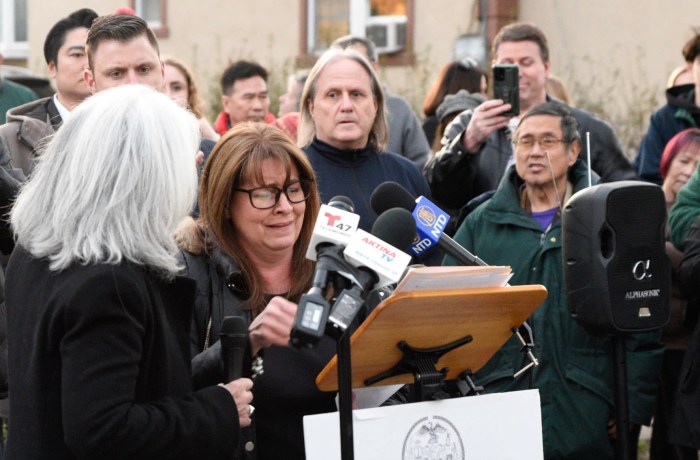BY LESLEY SUSSMAN | A massive redevelopment plan for the Seward Park Urban Renewal Area, delayed for nearly a half century because of lack of community consensus, is expected to come up for a vote by the City Council early next month. If passed, it would then need approval from the mayor.
SPURA is a 1.65-million-square-foot swath of land at the foot of the Williamsburg Bridge. The site essentially consists of five undeveloped lots just south of Delancey St. and is the largest city-owned, undeveloped site in Manhattan south of 96th St. The sprawling property is currently home to several open-air parking lots.
The current plan for SPURA calls for 900 units of housing — 50 percent of them permanently affordable — and a large amount of commercial space for stores, community facilities, a small park, a luxury hotel and a new Essex Street Market on the south side of Delancey St. The proposal has won the approval of both Community Board 3 and the City Planning Commission.
The City Council vote is expected to take place the second week of October, possibly on Thurs., Oct. 11, after the Council receives the recommendations of its subcommittee on Planning, Dispositions and Concessions. The subcommittee held the last public hearing on SPURA last Wednesday as part of the city’s Uniform Land Use Review Procedure (ULURP).
At Wednesday’s lengthy, four-hour subcommittee hearing, held in the City Council Chambers and co-chaired by Brooklyn Councilmember Stephen Levin and Margaret Chin, whose district contains SPURA, about 200 residents from the Lower East Side and Chinatown packed the room. Also in attendance were officials from various city agencies involved in the planning process.
Activists from several grassroots community organizations spoke out strongly against the proposal. Many of them wore T-shirts that read, “Say No to SPURA. Schools and Small Stores for Our Neighborhood.”
Meanwhile, C.B. 3 and other SPURA supporters wearing bright yellow T-shirts that read, “Yes to SPURA,” tried to sway subcommittee members to their side. Each speaker was given two minutes to testify.
Opening the hearing was Councilmember Chin, who gave an impassioned speech in favor of the proposal.
“The value of the Seward Park Urban Renewal site cannot be measured in dollars,” Chin said. “The value can only be measured in how much affordable housing it can provide a community that has some of the worst overcrowding in the city. The value can only be measured in how many homes for seniors it can provide a community that is rapidly aging in place. And the value can only be measured in how much affordable incubator space it can provide for start-up businesses for a new generation of creative minds in the tech, fashion and art industries.”
Chin also said that she was strongly opposed to any new hotels on the site.
“There is no need for it,” she stated. “Our hotel market is already oversaturated with several uncompleted hotels standing there. We need commercial office buildings to bring people here during the day.”
At a press conference held the day before the hearing, Chin had come under sharp attack by the Coalition to Protect Chinatown and the Lower East Side. The coalition criticized Chin’s decision not to push for 100 percent affordable housing on SPURA but instead support a 50 percent affordable/50 percent market-rate housing compromise worked out between the city and C.B. 3.
However, during her remarks before the subcommittee, Chin said, “I remain committed to maximizing the number of affordable housing units on the SPURA site and I will find ways to increase the number of affordable units and make smarter use of our space.”
The councilmember commended the plan’s inclusion of permanent affordable housing for 50 percent of the 900 units on the site, but added that she wanted to see the city “give priority” to developers who want to build even more affordable housing there.
Meanwhile, another grassroots organization, the L.E.S. United Against Walmart — a coalition of community-based organizations and labor unions —said it has been trying to convince Chin to add language to the proposal that would ensure that big-box stores, notably Walmart, are not allowed to do business on the site.
“We’re really putting pressure on Councilwoman Chin to place restrictions on the square footage of retail development on the site and ensure that the Essex Streeet Market vendors are protected,” said Raymond Rodriquez, a spokesperson for the group.
Rodriquez said the community-based organization was particularly interested in a 30,000-square-foot cap for retail spaces developed on the site, wage standards for all workers, 50 percent local hiring for all commercial businesses at the site, and that the city cover all moving expenses for Essex Street Market vendors who will be forced to relocate across the street to the new market facility. The activist group also wants to ensure that market vendors won’t have to pay more rent at the new location than they are currently paying.
In another development at the Tuesday press conference, the Coalition to Protect Chinatown and the Lower East Side announced that it had been joined by a developer committed to building 100 percent low-income housing on the 10 blocks of city-owned land.
The developer was identified as Ben Wong, the founder of the Chinese fast-food chain Wok & Roll. The coalition said Wong was also committed to developing spaces for small businesses and community services, such as a public school, daycare center and health clinic, and making sure that local residents had first priority for jobs.
At the trilingual press conference in Cantonese, Spanish and English, Wong said he had another idea that would improve neighborhood life — the construction of a “Grand Central-like” bus station for Chinatown bus companies.
Wong said such a terminal would encourage local pedestrian traffic to the area. He added that students from Pratt Institute have already committed to the project, and also students from the University of Hong Kong, who would offer “free advice and a good design.” The developer explained that the financing for his project would come from his various financial contacts within HSBC, Chase bank and the Shanghai Commercial Bank.
The first panel of local residents to testify at the Sept. 19 subcommittee hearing were current C.B. 3 Chairperson Gigi Li and former Chairpersons Dominic Berg and Dave McWater, who all advocated for the proposal.
“This plan represents a responsible and balanced approach to development,” Li said. “It’s a unified community vision of the future.”
McWater, meanwhile, told subcommittee members, “Everyone was a winner with this plan. There will be five times as much affordable housing as the last plan, and it will create more local jobs.”
Berg, in his remarks, placed an emphasis on the need for “more schools on the development site for the thousands of people who will move here.”
Also speaking out in support of the plan was a group calling itself the Citizens Housing and Planning Council. A spokesperson for the organization, however, requested that the limit of 450 units of affordable housing be lifted so more such housing could be built.
Among those speaking against the proposal was Esther Wang, project director for the Chinatown Tenants Union. She asked for an inclusion in the plan limiting retail space to parcels of fewer than 30,000 square feet to ward off big-box stores.
“What we need in Chinatown and the Lower East Side is good jobs and good affordable housing, not Walmart,” Wang said. She expressed concern over the impact a large chain store could have on businesses that already exist in the area. She also requested that the project stipulate that future retailers make at least 50 percent of their hires from the neighborhood.
Also speaking out against the plan as currently drafted was Rosa Castro, who said she was a lifelong Lower East Side resident who grew up in public housing.
“We don’t want the city to take what is ours,” she said. “We want 100 percent low-income housing on the SPURA site.”
Later during the hearing, C.B. 3 Chairperson Li told this newspaper that she felt the session went well for SPURA supporters.
“I think the community board has really been consistent on what it believes the priorities are, and that we stand behind the resolution that has been unanimously passed,” she said, referring to C.B. 3’s vote on SPURA. “We hope that with the help of our elected officials it will go through these committees and be approved by the mayor,” she said.
Li said the large turnout of community residents opposed to the proposal did not faze her.
“Everyone has different expectations of what they would like to see out of this project, and I think it’s great that they’re participating in the process,” she said. “But I think there are some budgetary realities that we have struggled with and reached a conclusion on.”
There have been scattered development projects on parts of the SPURA site over the years. But most of the property has sat vacant for more than 40 years after the city razed tenement buildings as part of an urban renewal effort and displaced thousands of low-income residents. These tenants and their descendents will be given first priority to live in the new development, according to the city.
A representative of the city’s Economic Development Commission told the subcommittee that her agency was making “tremendous efforts to identify those tenants and get information to them about housing opportunities.”
The stalled project got new life in 2011 when C.B. 3, after two years of contentious debate, voted nearly unanimously to approve new development guidelines for the site that were drafted by the city’s Department of Housing Preservation and Development and E.D.C.
C.B. 3 added several of its own development guidelines to the proposal and has repeatedly stated that the modified proposal best serves the diverse interests of the community.

















